Installing and configuring FreeBSD 8.1 and 7.3 under Hyper-V 2008 R2
A couple of years ago, I wrote about running FreeBSD 6.3 and 7.0 under Hyper-V version 1 . FreeBSD is developing, and Hyper-V does not stand still. The problems I described earlier have disappeared and now FreeBSD works much better in our virtualization system.
Today we will be installing FreeBSD 8.1 and 7.3, because it is they that are officially recommended at the moment. We also check how the system works in a multiprocessor configuration, and what device speeds are shown during tests.
Due to the fact that the integration components for FreeBSD do not exist, only emulated devices will be available to us. Therefore, before installing the OS, we remove the synthetic network adapter from the virtual machine and add the Legacy network adapter.
')

After that, you can run the installation. Here everything is trivial and happens, as well as on real hardware. After the installation is complete, we see that the OS has booted normally and there are no problems with power management, which were 2 years ago. Therefore, there is no need to apply patches to the kernel.
After the reboot, add the description of the de0 network interface to /etc/rc.conf so that it can work with DHCP:
ifconfig_de0 = ”DHCP media 100baseTX mediaopt full-duplex”
Execute commands:
# ifconfig de0 down
# ifconfig de0 up
# dhclient de0
And enjoy the working network.


The network speed is on average 95.57 Mbps, although sometimes peaks of up to 103 Mbps are obtained. The result of ten tests can be seen in the screenshot.
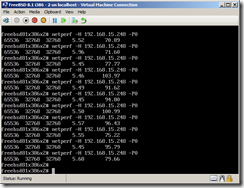
If the speed of 100 Mbit / s is insufficient for your tasks, then you can give the virtual machine 4 network adapters at 100 Mbit / s and link them into one high-speed interface using the aggregation mechanism of connections.
The speed of the hard drives can be seen on the next screen.
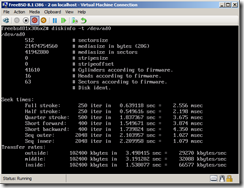
Hyper-V allows you to give each guest machine up to 4 virtual processors. FreeBSD works great in this configuration.
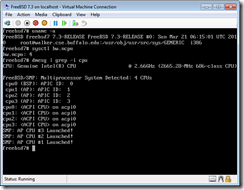
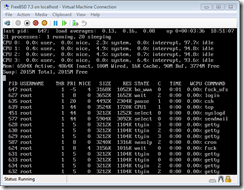
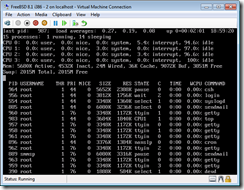
With the work of the video adapter, too, there are no problems. Xorg was launched from the first attempt, recognized all the necessary devices and worked without any problems.
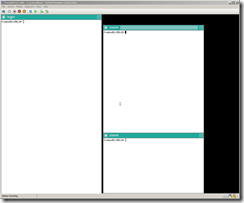
Contrary to the common meme, the KDE patch for FreeBSD was not necessary. KDE earned the same from the first attempt.
As usual, before writing the article, I left the FreeBSD virtual machine to work for several days and with the help of scripts I downloaded and downloaded several gigabytes of data via FTP and SSH.
Based on this, I conclude that FreeBSD running under Hyper-V is stable and can be used to implement infrastructure services, training, development or testing.
Today we will be installing FreeBSD 8.1 and 7.3, because it is they that are officially recommended at the moment. We also check how the system works in a multiprocessor configuration, and what device speeds are shown during tests.
Due to the fact that the integration components for FreeBSD do not exist, only emulated devices will be available to us. Therefore, before installing the OS, we remove the synthetic network adapter from the virtual machine and add the Legacy network adapter.
')

After that, you can run the installation. Here everything is trivial and happens, as well as on real hardware. After the installation is complete, we see that the OS has booted normally and there are no problems with power management, which were 2 years ago. Therefore, there is no need to apply patches to the kernel.
After the reboot, add the description of the de0 network interface to /etc/rc.conf so that it can work with DHCP:
ifconfig_de0 = ”DHCP media 100baseTX mediaopt full-duplex”
Execute commands:
# ifconfig de0 down
# ifconfig de0 up
# dhclient de0
And enjoy the working network.


The network speed is on average 95.57 Mbps, although sometimes peaks of up to 103 Mbps are obtained. The result of ten tests can be seen in the screenshot.

If the speed of 100 Mbit / s is insufficient for your tasks, then you can give the virtual machine 4 network adapters at 100 Mbit / s and link them into one high-speed interface using the aggregation mechanism of connections.
The speed of the hard drives can be seen on the next screen.

Hyper-V allows you to give each guest machine up to 4 virtual processors. FreeBSD works great in this configuration.



With the work of the video adapter, too, there are no problems. Xorg was launched from the first attempt, recognized all the necessary devices and worked without any problems.

Contrary to the common meme, the KDE patch for FreeBSD was not necessary. KDE earned the same from the first attempt.
As usual, before writing the article, I left the FreeBSD virtual machine to work for several days and with the help of scripts I downloaded and downloaded several gigabytes of data via FTP and SSH.
Based on this, I conclude that FreeBSD running under Hyper-V is stable and can be used to implement infrastructure services, training, development or testing.
Source: https://habr.com/ru/post/103924/
All Articles